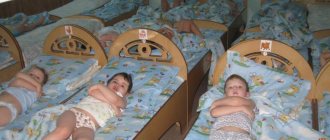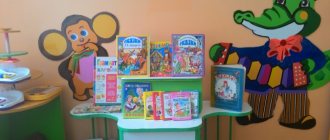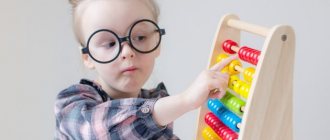Holding a wake-up call depending on the time of year and month
Wake up involves waking up children to calm melodious music, after which the kids must perform several physical exercises right in bed. Depending on what time of year it is outside, the melody can be different: quiet and classic if it is raining or snowing in winter, catchy and cheerful if the weather is sunny and warm outside.
The process of waking up children
Children should wake up and turn in different directions to the beat of the music, stroke their legs, spread their arms, clench and unclench their hands, and bend their knees. Everything is done strictly one by one, after which all children must stand on the massage carpet and perform several breathing exercises.
Gymnastics after waking up helps the child concentrate on subsequent lessons, strengthens children's physical health and improves their mood. It is for these reasons that the teacher should work with his pupils regularly, alternating games among themselves so that the children do not get tired of them.
Physical education classes in kindergarten. Second junior group (9 pages)
Rice. 10
4. I. p. - feet shoulder-width apart, hoop in bent arms near the chest. Turn right (left) slowly; straighten up, return to the starting position.
Main types of movements.
Jumping "Through the Swamp". From 8-10 flat card hoops (or cords) with a diameter of 30–40 cm, “bumps” are laid out in a checkerboard pattern on two sides of the hall. Children stand in two columns. The teacher suggests crossing the “swamp” by jumping on two legs from one “bump” to another. Jumps are performed alternately, one after another. The teacher reminds that you need to jump with your knees bent and land on bent legs (there should be a certain distance between the children).
After all the guys have “crossed the swamp,” there is a short pause, and the game task is repeated. The number of repetitions depends on the conditions and physical fitness of the children. The pace of exercise is moderate.
Rolling balls “Accurate pass”. Children stand in two lines following landmarks (cord, colored marks). The distance between the ranks is 2 m. One rank receives balls (or children take balls from the basket). At the teacher’s signal: “Let’s go!” – children roll the balls with an energetic movement with both hands towards a partner from another line (pairs are determined in advance). The game task is repeated 8-10 times in a row.
Outdoor game “Mice in the pantry”. The “mice” children sit in “holes” - on benches placed along one wall of the hall. On the opposite side of the hall there is a rope stretched at a height of 50 cm from the floor level, behind it there is a “storage room”.
The teacher, the “cat,” sits next to the players. “Cat” falls asleep, and “Matti” runs to the pantry. Entering the pantry, they bend down so as not to touch the rope. There they squat down and “gnaw crackers.” The “cat” wakes up, meows and runs after the “mice”. They run away into the “holes” (the cat does not catch mice, but only pretends to want to catch them). The game resumes. After some time, when the game is repeated, the role of the cat can be played by the most prepared child.
3rd part. Game “Where is the mouse hiding?”
Lesson 11
Tasks. Develop the ability to act on a signal from the teacher; develop coordination of movements and dexterity when rolling the ball between objects; practice crawling.
Part 1. Game exercise “Your cube”. Cubes are laid out in a circle (according to the number of children). Walking in circles. After the children have walked half the circle, the teacher gives the command: “Take the cube!” Children turn to face in a circle, each child takes the cube that is closest to him and raises it above his head.
To the teacher’s next command: “Circle!” - children put the cubes in place, and walk in a circle in the other direction. The exercise is repeated. After walking, you run in a circle, first in one direction and then in the other direction.
Part 2. General developmental exercises.
1. I. p. - legs at the width of the foot, arms along the body. Raise your arms up, stretch, squat, put your hands on your knees (5 times).
2. I. p. - sitting on the floor, legs apart, arms supported behind. Raise your right (left) leg forward and up; lower your leg, return to the starting position (3 times with each leg).
3. I. p. - lying on your stomach, arms bent at the elbows in front of you. Understand that your arms are forward and up, your legs are slightly raised - “fish”. Return to starting position (5 times).
4. I. p. - standing, feet shoulder-width apart, hands on the belt. Tilt the torso to the right (left), straighten up, return to the starting position (3 times in each direction).
Main types of movements.
Game task with the ball “Ride it, don’t hit it.” Children stand in two lines, each child has a ball of medium diameter. The teacher places cubes (or medicine balls) along the hall in two lines, at a distance of 1 m from each other (5-6 pieces each). One child from each rank stands on the starting line and begins to roll the ball between objects, pushing it with both hands, without letting it go far from them. The teacher invites the next pair of children as soon as the previous children have covered a third of the distance, and so, one after another, the children perform the exercise. After completing the task, children approach the hoop, take a step and raise the ball high above their heads. The child must return to his line from the outside.
“Crawl through - don’t hit me.” Crawling on all fours (supporting on the palms and knees) between objects without touching them (“snake”). The game task “Fast Bugs” is performed in two columns (organization is approximately the same as in the previous exercise; after crawling, stand up, straighten up and clap your hands above your head).
Outdoor game “On a level path.” The teacher brings the children into a circle and invites them to play. Reads a poem:
On a smooth path,
On a flat path
Our feet are walking:
One, two, one, two,
By pebbles, by pebbles...
Into the pit - bang!
Children perform walking, and to the words “over the pebbles, over the pebbles” they jump on two legs, moving forward slightly, to the words “into the hole - bang!” squat down. “We got out of the hole,” says the teacher, and the children rise. The game repeats itself. In order to prolong one or another type of movement of children, the teacher can repeat each line of the poem several times.
3rd part. Walking in a column one at a time or a low-mobility game at the children's choice.
Lesson 12
Tasks. Exercise children in walking while completing tasks, developing attention and reaction to the teacher’s signal; in crawling, developing coordination of movements; in balance.
Part 1. Walking in a column one at a time to complete a task, running in a column one at a time. The teacher explains the task to the children: the word: “Frogs!” – sit down, put your hands on your knees, then get up and continue walking. Switch to running at the teacher’s signal and then start walking again. To the word: “Butterflies!” – stop and wave your arms like wings. Walking and running are carried out in alternation.
Part 2. General developmental exercises with flags.
1. I. p. – legs at the width of the foot, flags in both hands below. Raise the flags up, arms straight; lower the flags, return to the starting position (5 times).
2. I. p. – feet shoulder-width apart, flags at the shoulders. Turn to the right, right hand to the right, straighten up, return to the starting position. The same to the left (3 times in each direction).
3. I. p. - feet shoulder-width apart, hands with flags behind the back. Lean forward and down and wave the flags left and right. Straighten up, return to the starting position (5-6 times).
4. I. p. - feet width apart, flags below. Wave the flags back and forth. Lower the flags down, return to the starting position (4-5 times).
5. Walking in a column one at a time. Children place flags in the place indicated by the teacher (running with flags should be excluded due to possible injuries).
Main types of movements.
Crawl. Game task – “Spiders”. Two boards are laid parallel to one another on two sides of the hall. Children crawl in two columns along the board, supported on their palms and knees, quickly - “like spiders.” The teacher adjusts the distance between the children so that they do not bump into each other. After crawling, the child approaches the cord, steps over it and claps his hands above his head (repeat 3 times).
Equilibrium. On the side of each board, approximately in the middle, a cube (or any object) is placed on the floor. Walking is performed at a moderate pace at a short distance from each other - arms to the sides, balancing freely, helping to maintain stable balance. You need to stop near the cube, perform a squat (not very deep) and continue walking. The teacher reminds the children that at the end of the exercise they need to go around the board from the outside and go to their column (2-3 times).
Outdoor game “Catch a mosquito.” The players stand in a circle with their arms raised to the sides. The teacher is in the center of the circle and rotates a stick with a long rope at a distance of approximately 120 cm from the floor in both directions, to the end of which a mosquito (cut out of cardboard) is attached. As the mosquito approaches, children jump up on two legs, trying to touch (catch) the mosquito.
3rd part. Walking in a column, one at a time, behind the “mosquito”. The stick with the “mosquito” is carried at the head of the column by the child who managed to catch it more often than others in the game.
Material to repeat
1st week. Game exercises: climbing under an arc (cords); with a ball - “Roll the ball and crawl”, “Roll and catch the ball; balance – “Run along the bridge (along the path).” Outdoor games “Mice in the pantry”, “Train”, “On a level path”.
2nd week. Game exercises: balance - walking from hoop to hoop; jumping - “Jump from hole to hole (from hoop to hoop). Outdoor games “Hen and Chicks”, “Catch the Ball”.
3rd week. Game exercises: jumping - to a cube, to a hoop, to a toy; “Jump over the stream”; with a ball - “Roll the ball to the pin and knock it down.” Outdoor games “Catch a mosquito”, “Cat and mice”, “Find your house”.
4th week. Game exercises with a ball - rolling balls in pairs; “Ride through the gate”; crawling - “Crawl to the bunny (on your palms and knees), climbing under an arc (“mice”, “kittens”). Outdoor games “Bubble”, “Catch a mosquito”, “Grey bunny washes himself”.
On the topic: methodological developments, presentations and notes
Arouse in children an emotional response to reading a nursery rhyme; psychologically prepare each child to overcome obstacles and jump over a line; encourage children to participate in outdoor games.
Generalization from work experience “Regular moments in kindergarten: getting up after sleep.”
Goal: Health promotion, prevention of colds and flat feet. Objectives: 1. Contribute to the quick and comfortable awakening of children after sleep.2. Increase vitality and resistance.
The correct daily routine is a rational duration and reasonable alternation of various types of activities and rest for children during the day, an indispensable condition for a healthy lifestyle and a successful time.
Goals: Expand knowledge about seasonal changes in nature. Develop cognitive activity in children. Continue familiarization with leaves, highlighting characteristic features and changes associated with the time of year.
getting up of 2-3 year old children after sleep, the regime in kindergarten and its features.
Source
Invigorating gymnastics after sleep in the middle group: a file cabinet according to the Federal State Educational Standard
In the card index of exercises for invigorating exercises, a couple of the most popular ones are highlighted. These are “Clapperboard” and “Drawing with Legs”. When performing the first exercise, children should kneel and place their hands on their waists. As you inhale, you should spread your arms to the sides, and as you exhale, lower them down, clap your hands and say: “Clap!”
Note! The exercise must be repeated at least 7-8 times.
During the “Drawing with Legs” exercise, the child must draw geometric shapes (rhombus, square or triangle) in the air with his feet. Next, place the legs so that the entire foot touches the floor, and then rise on the toes, lifting the heels off the floor as much as possible. While in the starting position, raise your fingers up, without lifting your feet off the floor even a millimeter.
Physical education of children in the family
Methodology for conducting invigorating gymnastics: time plan and example notes
To maintain interest and maintain the child’s emotional state, you need to follow a clear time frame throughout the exercise. Exercises in bed immediately after waking up should last at least 2.5-3 minutes, the active block - 3-4 minutes, and breathing exercises - 2-3 minutes.
Active exercise in the garden
Note! Children should walk on massage mats for 1 minute. Tasks should be combined in such a way that the entire lesson lasts no more than 10 minutes.
The teacher's standard summary must indicate the educational area, location, explanatory note and objectives of the lesson. In the line “educational area” you need to enter physical development, in the “venue” - a playroom or bedroom of a kindergarten group. As for the main goals, the following are suitable:
- developing motivation to maintain and strengthen one’s health;
- eliminating drowsiness and lethargy in children through physical activity;
- formation of correct posture and prevention of the development of flat feet.
Also in the summary it is worth mentioning social-communicative, cognitive, speech and artistic-aesthetic development. Social-communicative involves nurturing friendly relationships between all students in the group, so that they learn to be mutually polite and make concessions. In the process of cognitive development, children consolidate their existing knowledge about the world around them and its components.
As for speech development, with its help the articulatory apparatus is prepared to pronounce sounds correctly, and the child’s vocabulary is also enriched.
Note! In the process of artistic and aesthetic development, the baby develops an interest in art, music and a sense of rhythm.
Also in the notes you need to write down the type of activity (game, communicative, motor or cognitive) and equipment that may be needed during the gymnastics class. You can use ribbed tracks, colored sheets, gymnastic hoops or massage balls.




